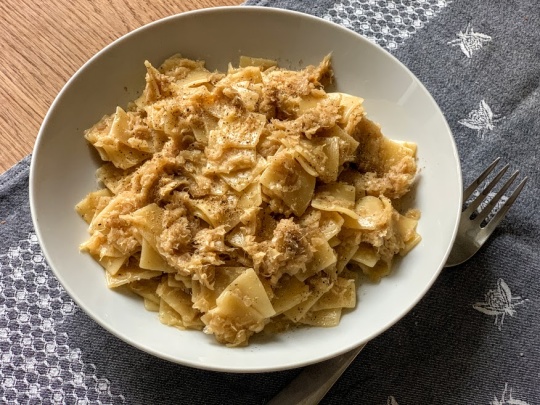
Hungarians have been eating both cabbage and noodles for hundreds of years, so it’s no surprise that the two appear together in this dish. The shredded and roasted cabbage coats every inch of the square-shaped bits of slippery pasta. A bit of sugar adds sweetness, and a generous seasoning of freshly ground peppers lends the dish its signature pungent flavor.
Ingredients
Yield: 4 servings; Total time: 1 hour
1 large cabbage, outer leaves discarded then cored and grated or finely shredded
1 tablespoon salt, for the cabbage to release water
2 tablespoons schmaltz (goose fat), lard, or vegetable oil
1 large tablespoon sugar
1 teaspoon freshly ground black pepper
Salt to taste
350 grams (¾ pound) dried pasta, ideally the flat and square-shaped Hungarian csusza or kocka variety, but you can also use lasagne pasta, cracking the sheets into 1 ½-inch bits.
Directions
Step 1: Place the grated or finely shredded cabbage in a mixing bowl. Add salt and mix well with the cabbage. Put aside for 15 minutes for cabbage to release water.
Step 2: Heat lard or oil in a large pot or skillet on medium. Take a handful of cabbage from the mixing bowl, squeeze to remove as much water as possible, then transfer cabbage to the pot. Repeat for the remaining cabbage.
Step 3: Stirring regularly, roast the shredded cabbage on medium heat until it takes on a uniform brown color, about 45 minutes (don't let the cabbage unattended because it will burn). Toward the end, add sugar and freshly ground pepper and mix well.
Step 4: When the cabbage is nearly finished, bring a pot of salted water to a boil and cook pasta until al dente, about 7-8 minutes. Drain pasta (keep a few ladles of the starchy pasta water), then add it to the cabbage and mix well until pasta is thoroughly covered with cabbage on all sides. Ladle some of the starchy pasta water until pasta is slippery. Taste for salt and add some if needed.
Step 5: Spoon the pasta onto the serving plates and serve while still hot.
Words of advice
In Hungary, many people turn this into a sweet noodle dish, finishing it with powdered sugar. Bizarre it may sound, it’s actually very tasty.
I created these recipes with the help of nearly a dozen historical Hungarian cookbooks, adjusting ingredients, cooking times, and methods to reflect my own preferences and tastes of the current day. Do you have any feedback? Please let me know!